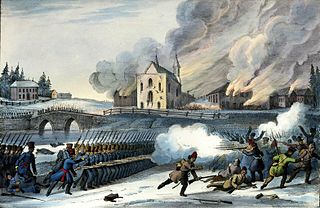
Longueuil is a city in the province of Quebec, Canada. It is the seat of the Montérégie administrative region and the central city of the urban agglomeration of Longueuil. It sits on the south shore of the Saint Lawrence River directly across from Montreal. The population as of the Canada 2016 Census totalled 239,700, making it Montreal's second largest suburb, the fifth most populous city in Quebec and twentieth largest in Canada.

Pierre Gaultier de Varennes, sieur de La Vérendrye was a French Canadian military officer, fur trader and explorer. In the 1730s, he and his four sons explored the area west of Lake Superior and established trading posts there. They were part of a process that added Western Canada to the original New France territory that was centred along the Saint Lawrence basin.

The Lower Canada Rebellion, commonly referred to as the Patriots' War in French, is the name given to the armed conflict in 1837–38 between the rebels of Lower Canada and the government of Lower Canada. Together with the simultaneous rebellion in the neighbouring colony of Upper Canada, it formed the Rebellions of 1837–38.

Saguenay–Lac-Saint-Jean is a region in Quebec, Canada. It contains the Saguenay Fjord, the estuary of the Saguenay River, stretching through much of the region. It is also known as Sagamie in French, from the first part of "Saguenay" and the last part of "Piekouagami", the Innu name for Lac Saint-Jean, with the final "e" added to follow the model of other existing region names such as Mauricie, Témiscamie, Jamésie, and Matawinie. The name Saguenay is possibly derived from the Innu word "Saki-nip" which means "where water flows out". With a land area of 98,712.71 km2, the Saguenay–Lac-Saint-Jean is, after the Nord-du-Québec and Côte-Nord regions, the third-largest of Quebec regions in the area.

Trois-Rivières is a city in the Mauricie administrative region of Quebec, Canada, at the confluence of the Saint-Maurice and Saint Lawrence rivers, on the north shore of the Saint Lawrence River across from the city of Bécancour. It is part of the densely populated Quebec City–Windsor Corridor and is approximately halfway between Montreal and Quebec City. Trois-Rivières is the economic and cultural hub of the Mauricie region. The settlement was founded by French colonists on July 4, 1634, as the second permanent settlement in New France, after Quebec City in 1608. In 2016, the city's population was 134,413.

The Slavey are a First Nations indigenous peoples of the Dene group, indigenous to the Great Slave Lake region, in Canada's Northwest Territories, and extending into northeastern British Columbia and northwestern Alberta.

Wolfred Nelson was the mayor of Montreal, Quebec, from 1854 to 1856.

Burnham Thorpe is a small village and civil parish on the River Burn and near the coast of Norfolk, England. It is famous for being the birthplace of Vice Admiral Horatio Nelson, victor at the Battle of Trafalgar and one of Britain's greatest heroes. At the time of his birth, Nelson's father, Edmund Nelson, was rector of the church in Burnham Thorpe.

Saint-Denis-sur-Richelieu is a municipality in the southwestern part of Quebec, Canada on the Richelieu River in the Regional County Municipality of La Vallée-du-Richelieu. The population as of the Canada 2011 Census was 2,285.

Verberie is a commune in the Oise department in northern France.

The Battle of Saint-Denis was fought on November 23, 1837, between British colonial authorities under Lieutenant-Colonel Gore and Patriote rebels in Lower Canada as part of the Lower Canada Rebellion. The Patriotes were led by Wolfred Nelson. Gore was sent to quell the uprising in the Richelieu River valley in conjunction with a force led by Lieutenant-Colonel George Wetherall. Gore was the first to arrive at a Patriote-held site. Nelson had organized the defence with most of the well-armed rebels within a stone house that overlooked the road. Gore, accompanied by only one cannon, attempted to take the stone house three times, with the cannon providing ineffective fire. Another attempt to flank the house to the left failed when Gore's soldiers encountered the less well-armed militia. Running out of ammunition, the British retreated. This marked the only Patriote victory in 1837, as this battle was followed by two defeats at Saint-Charles and Saint-Eustache.

The Battle of Saint-Charles was fought on 25 November 1837 between the Government of Lower Canada, supported by the United Kingdom, and Patriote rebels. Following the opening Patriote victory of the Lower Canada Rebellion at the Battle of Saint-Denis, British troops under the command of Lieutenant Colonel George Wetherall advanced from the south on the Patriote stronghold of Saint-Charles in the Richelieu valley. On 25 November 1837 they engaged the Patriote forces under the command of Thomas Storrow Brown. After a two-hour battle, the Government of Lower Canada was victorious.
Sir Thomas Temple, 1st Baronet of Nova Scotia was a British proprietor and governor of Acadia/Nova Scotia (1657–70). In 1662, he was created a Baronet of Nova Scotia by Charles II.

The Assembly of the Six Counties was an assembly of Patriote leaders and approximately 6,000 followers held in Saint-Charles, Lower Canada on October 23 and October 24, 1837, despite the June 15 Proclamation of the government forbidding public assemblies.

The Saint-Charles River is the main watercourse crossing the city of Quebec, in the administrative region from Capitale-Nationale, in the province of Quebec, in Canada.
George Frederick Baird was a Canadian politician and lawyer, having studied in the firm of Charles Nelson Skinner.

The Nelson River is located in the administrative region of Capitale-Nationale, in province of Quebec, in Canada. It is part of the watershed of the Saint-Charles River. The course of this river crosses:

La Petite Rivière is a tributary stream of the Nelson River, flowing in the administrative region of Capitale-Nationale, in the province from Quebec, to Canada. The course of the river crosses:















